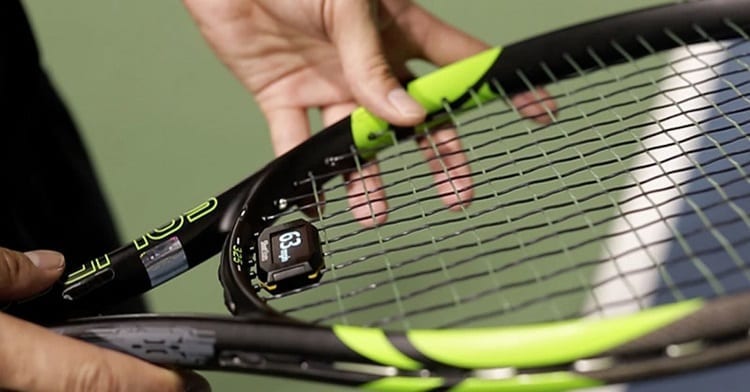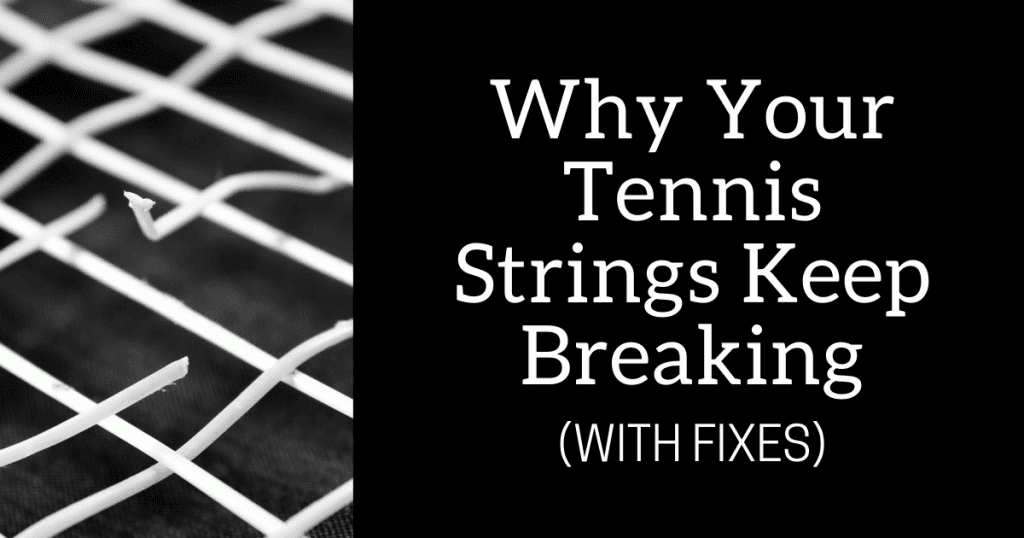Broken tennis strings are common and annoying, but a part of the game.
You’re in the middle of a match, you take a healthy swing at the ball, and you hear this PANG noise. Boom – your strings have broken and the racket is useless for the rest of the match.
Happens to everyone, but you can minimize the likelihood of it happening to you again.
We’re going to break down the reasons why tennis racket strings break and include some solutions you can implement to reduce the chances of it happening as frequently.
Tension and string type are the two biggies. Many tennis players use a tension that’s too tight for their playing style. Others use strings that are too thin for their playing style.
Let’s get started with a little lesson on your game style and how your strings are affected.
Contents
Spin: Topspin and Slice

Spin. It can the a great weapon when playing, but definitely degrades your strings over time.
Whether you’re hitting heavy topspin forehands or slicing backhands like it’s going out of style, constant spin will wear down your strings.
Hitting topspin groundstrokes means that your string is being twisted every time you make contact with the ball.
The spin is imparted onto the ball by the racket motion of brushing up on the ball when it is struck. When the ball comes into contact with the string bed, the strings move some.
Actually, they twist a little bit. Constant topspin and twisting of the tennis string causes it to weaken.
Though less so, similar movement to the string happens with slice shots. Backspin is imparted on the ball and the string twists in the opposite direction from when topspin is hit.
The constant ‘twisting’ of the string wears it out.
If your game works and you’re successful, don’t change a thing. Just be aware that your playing style contributes to a greater chance of broken tennis strings.
Hit the sweet spot of the racket as often as possible and keep doing your thing.
Pace: Hitting a Heavy Ball
Who do you think breaks more strings on their racket, Juan Martin del Potro or Roger Federer?
If I had to venture a guess, I’d say that Juan Martin del Potro does – hands down. The man has a rocket of a forehand.
He hits with so much pace that his strings take a beating every time he’s on court.
Should delPo change his style to save a few sets of string? Absolutely not.
But he and his team know that they’ll have to prepare him to bring more rackets to any match and shouldn’t be surprised when his strings break.
Being aware of how your playing style affects your equipment is key.
Should Tennis Strings Move?
Yes, they should have some give to them, but shouldn’t be moving all over the place.
The racquet string bed is either a single string used for both the main string and cross string, or two strings – one for the mains and one for the crosses. (We covered the ins and outs of racquet stringing here. Check it out for more info.)
As you impart spin and pace to your strokes, the strings will move. If the tension is very tight (high 60s to low 70s), the strings won’t move as much. If the tension is on the looser side (high 40s to mid 50s), the strings will move more.
Movement in the strings can be aggravating but isn’t detrimental to your game as long as you get the consistency and control that you need from how the tennis racquet was strung.
How Much Tension is Too Much?

Manufacturers determine the range of appropriate string tension.
Most rackets are made out of aluminum and are hollow to keep the overall weight down (8-12 oz).
Your manufacturer settings are there to define the best way to use the racket, but are not the only way.
However, sticking with manufacturer recommendations for optimal playing power and performance is recommended.
Lower tension equates to more power and higher tension equates to better control. Which aspect of your game needs more help? Once you figure that out, you have an idea of where to start for your racket’s tension.
Suggestions for Reducing the Frequency of Broken Tennis Strings
There are a few options for how to reduce how often you’re replacing your tennis strings due to a break.
You’re not going to find any magical formula, but combining some of these suggestions is sure to better preserve your racket strings.
1. Try a New String Material

Even if your strings aren’t broken, it may be time to switch them out for something else. And by something else, I mean the material they’re made of.
Most strings used in rackets today are made out of nylon. While nylon is a fine substance for strings, they’re not as stretchy as polyester, the other common type of string.
Using natural gut? It isn’t as durable as a synthetic material. If you’re breaking strings frequently, you might need to switch to something with a little more longevity.
2. Use a Different String Gauge
String comes in varying thickness from 15 gauge to 19 gauge.
You might think that 15 gauge would be thicker than 19 gauge. I don’t know why, but it’s the opposite. 19 gauge string is actually the thinnest (1.00 mm to 1.10 mm).
Captain Obvious aside, but thinner string isn’t as durable and breaks more quickly than thicker string.
If you’re using 17 gauge string and are breaking your strings too frequently for your taste, try out 16 gauge string and see if it helps with the longevity. Your feel will diminish slightly, but that might be an ok trade off for you to not be replacing strings all the time.
3. Lower the Tension

Is this breakage thing a common occurrence?
It’s time to lower that tension and let your strings breathe a bit.
Even if you are going to switch to a different string material or gauge, you can still lower the overall string tension by 5-10 lbs to experiment.
This change in tension will definitely change the way your racket feels when you make contact with the ball.
You might notice less vibration in your arm, and your groundstrokes may start to penetrate more deeply into the court.
4. Try a Hybrid Pattern
A hybrid stringing pattern uses two different strings when your tennis racket is restrung.
Not only can you use different strings in the mains and crosses, but you can use different tension as well. If the tension is distributed differently, you may feel less vibration and tension on your wrist.
When you use a single stringing method, the ball transports all of its energy into the single piece of string that runs throughout the racket.
With a hybrid pattern, it divides the tension to different strings so that you’re not stressing out the entire racket each time you make contact with the ball.
Hybrid stringing patterns can, at the very least, give you a few extra months of wear and tear before you have to have your racket restrung.
Keep Your Gear Maintained
Unless your strings break, your frequency of play will determine how often you should have to restring your racket. Do your best to keep your gear maintained year round.
It’s important to inspect your equipment periodically – even if you’re taking a break from playing tennis regularly.
Combining the right string (material and gauge) with the proper amount of tension on your racket (as defined by your manufacturer) may be your saving grace.
Give some of our suggestions a shot and perhaps your days of broken tennis strings will be a thing of the past.

